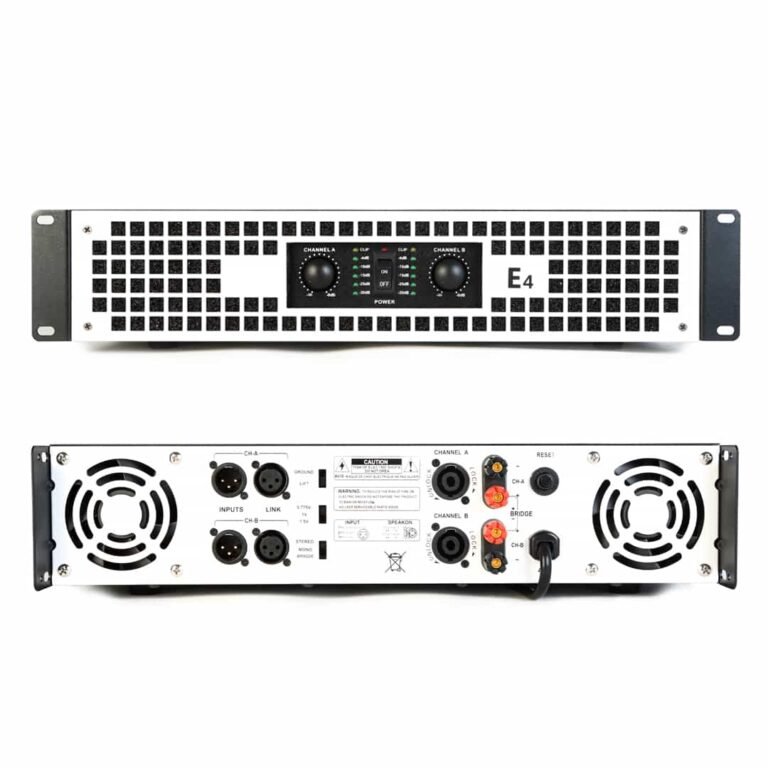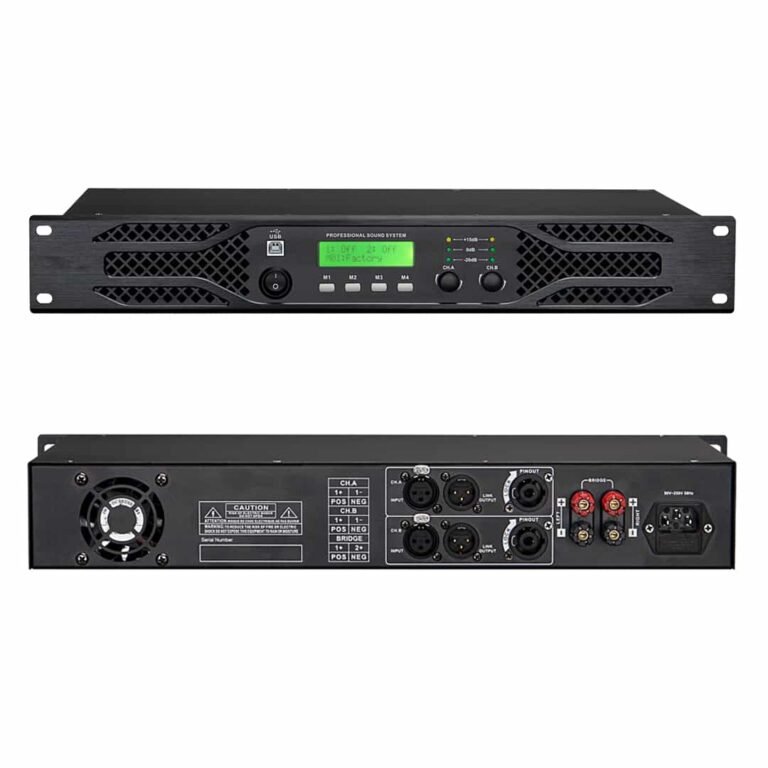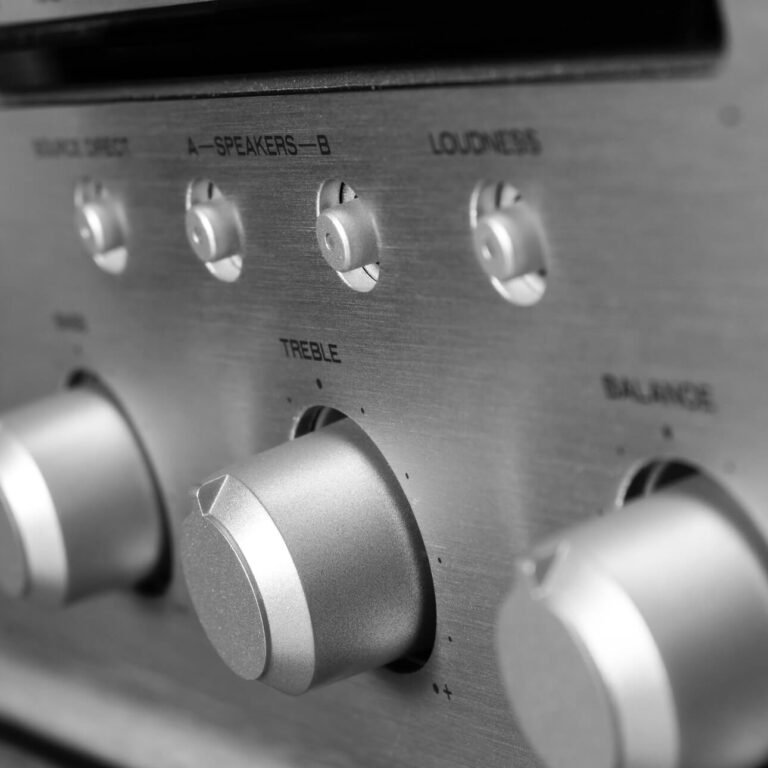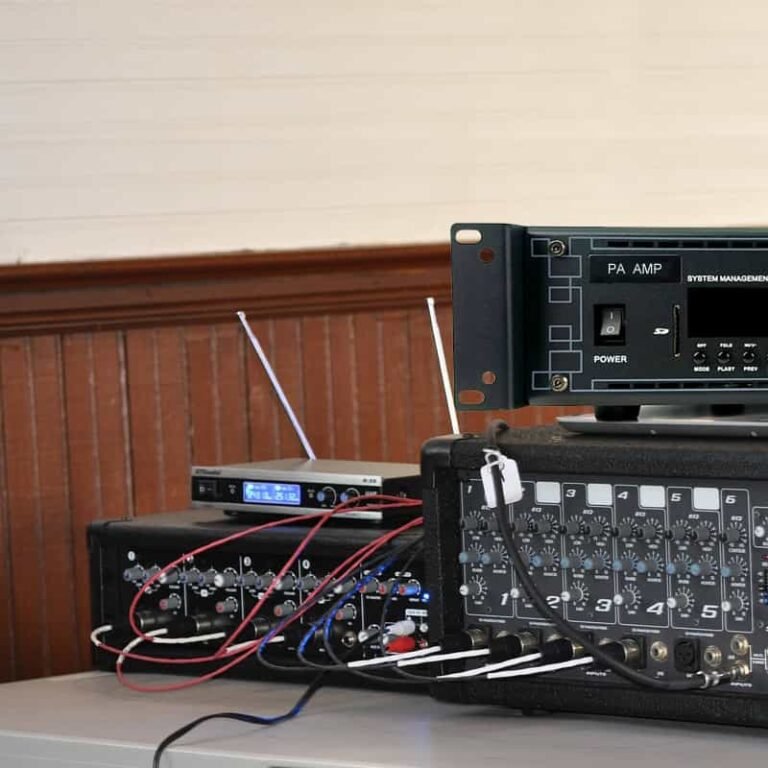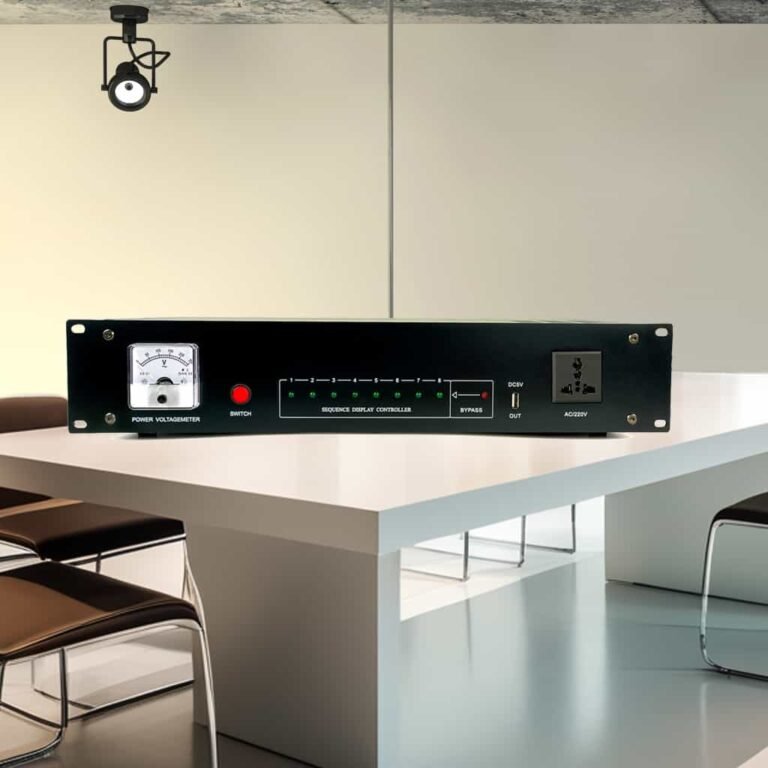As an important part of the public address system, emergency broadcast amplifiers deliver critical information during emergencies. Therefore, choosing the right emergency broadcast amplifier is crucial to ensure public safety and enhance emergency response efficiency. In this article, we will introduce the parameters and details of public address amplifiers to provide you with an exhaustive purchasing guide for emergency broadcasting amplifiers.
What is an Emergency Broadcast Amplifier
An emergency broadcast amplifier is an important component of a public address system, designed specifically to deliver critical information during an emergency. It is similar to a conventional public address amplifier. Still, it has a higher priority and greater stability to ensure that alerts, instructions, and other important information can be communicated quickly and accurately in an emergency.
Emergency broadcasting amplifiers are usually connected to an emergency broadcasting system that includes components such as microphones, PA amplifier,speakers, control equipment, and power supplies. In case of emergency, such as fire, earthquake, etc., the emergency broadcasting amplifier receives signals from the control center and immediately activates the broadcasting to send out alarms and instructions to the people in the building or a designated area.
Some Suggestions to Consider before Purchasing
1, Choose the Right Type of Amplifier
Emergency broadcasting amplifiers are mainly divided into two types: constant-voltage amplifiers and constant-resistance amplifiers.
Constant-voltage amplifiers are suitable for long-distance transmission and large-area coverage, while constant-resistance amplifiers are more suitable for small-area, high-fidelity application scenarios.
The following image of emergency broadcasting amplifiers with constant-voltage and constant-resistance dual-function. They can be applied flexibly, long-distance and small area are available.
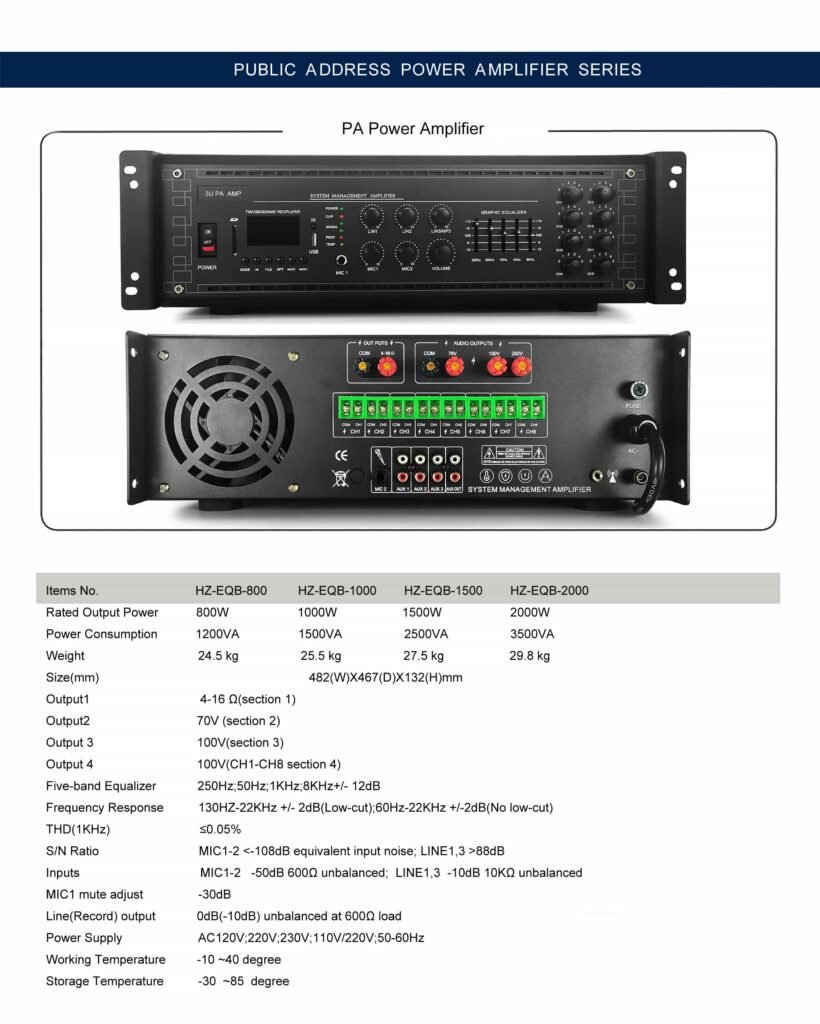
2, Focus On the Core Parameters
- Power Output: It is an important indicator to measure the performance of the amplifier. Should be based on the actual demand to choose the appropriate power output, not only to meet the coverage requirements but also to avoid waste of resources.
- Distortion: Distortion refers to the degree of difference between the output signal of the amplifier and the original signal. An amplifier with low distortion can ensure the clarity of sound quality and improve the audibility of broadcasting.
- Frequency Response: The wider the frequency response range, the stronger the amplifier’s ability to restore the audio signal. In the selection should pay attention to the frequency response range of the amplifier to ensure that it can meet the broadcasting needs.
- Dynamic Range: the wider the dynamic range, the stronger the amplifier’s ability to handle strong and weak signals. This is important for dealing with unexpected situations and ensuring the stability of the broadcast signal.
3, Understand the Components and Parts
Power supply units, transformers, electrolytic capacitors, resistors and capacitors, thermal management components, protection circuits, and connectors and cables are public address amplifier main components. They are critical to amplifier stability and reliability
- Power Supply Unit: A stable and pure power supply is the basis for the normal operation of the amplifier. The power supply unit should be able to provide sufficient current and stable voltage to cope with the transient current and voltage fluctuations generated when the amplifier works.
- Transformer: The transformer is responsible for converting AC power into low-voltage DC power required by the amplifier. Its quality directly affects the stability and reliability of the amplifier. Quality transformers can provide stable output voltage and effectively isolate the noise and interference in the power grid.
- Electrolytic Capacitors: Electrolytic capacitors in the amplifier play the role of rectifier filter, decoupling, and signal coupling. Its capacity and quality directly affect the stability and dynamic response of the amplifier. High-quality electrolytic capacitors can provide a better filtering effect, and reduce the power supply noise on the audio signal interference.
- Resistors and Capacitors: these basic components, although seemingly ordinary, play an important role in the amplifier. Their precision and stability directly affect the overall performance of the amplifier. Using high-quality, high-precision resistors and capacitors can improve the stability and audio quality of the amplifier.
- Thermal Management Components: Amplifiers generate a large amount of heat when they work, and if they do not emit this heat efficiently, it can lead to component damage or even cause malfunctions. Therefore, heat sinks, fans, and other thermal management components are essential to maintain the stability and reliability of the amplifier.
- Protection Circuit: the protection circuit includes over-current protection, over-voltage protection, overheating protection, etc., which can cut off the power supply in time when the amplifier is in an abnormal situation, and protect the amplifier and other components from damage. A perfect protection circuit can greatly improve the reliability of the amplifier.
- Connectors and Cables: Although these parts may seem inconspicuous, they play an important role in connecting various components in the amplifier. High-quality connectors and cables can ensure the smooth transmission of signals and currents, and reduce signal loss and interference.
Understanding the Expandability and Compatibility
With the development of technology and changing needs, the broadcasting system may need to be upgraded or expanded. Therefore, when selecting an emergency broadcast amplifier, its expandability and compatibility should be considered. This involves considering the kinds of inputs and outputs that are supported. This includes aspects such as support for new audio formats, ease of connectivity with other equipment, and ease of future upgrades.
Taking the following amplifier as an example, it considers expansion and compatibility for the user with a wide range of inputs and outputs functions.
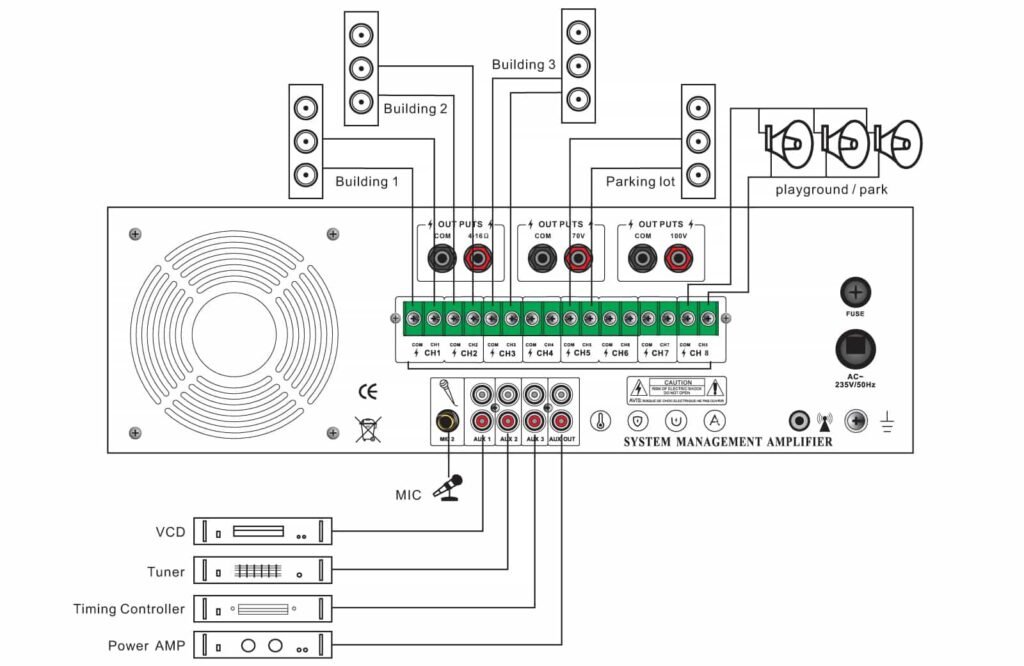
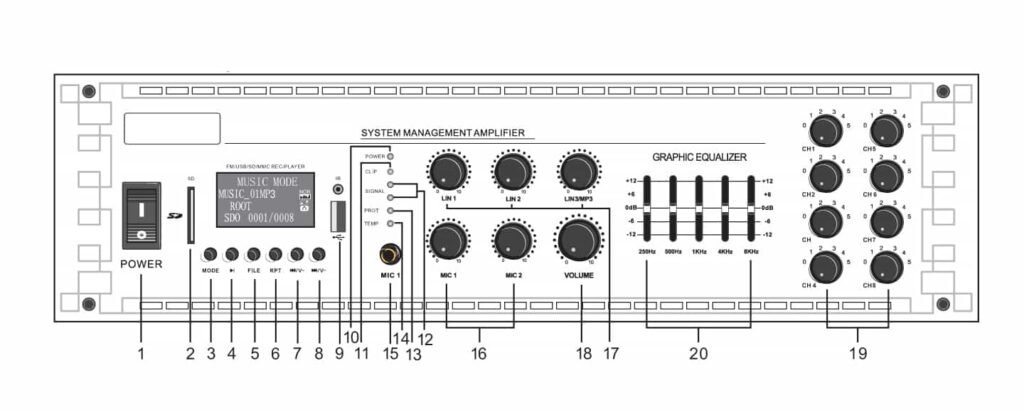
1. Power On/Off
2. SD Card Slot
3. Mode
Used to select the operating mode of the device, the operating mode cycles in the order of
“FM、AUX、MP3、Bluetooth”.
4. Play and Pause
Short press this button to get the next stored radio station, and long press it to search and
store stations automatically.
5. File/Folder
6. RPT/Repeat
7. V-
Short press this button to go to the previous song, long press this button to lower the volume.
In FM mode, press this key briefly to search for stations from high to low.
8. V+
Short press this button to go to the next song, long press this button to higher the volume.
In FM mode, press this key briefly to search for stations from low to high.
9. USB
10. Power Indicator
11.Clip
12.Output Level Indicator
13. Short Circuit Indicator/Overload Indicator
14.High Temperature Indicator
15. MIC 1 Input
This Microphone has the priority mute function
16. Buttons for Adjusting the Microphone Input Level
17. Buttons for Adjusting the Line and MP3 Input Level
18. Volume Final Output Adjustment
19. Individual Adjustment of Each Partition
20. Five-band Graphic Equalizer
Summary
Power amplifiers are an important part of an emergency broadcasting system to provide the required signal strength in a crisis to disseminate information to a wide audience. Procurement of emergency broadcasting power amplifiers is a decision-making process that requires comprehensive consideration of many factors. Choosing the right type of amplifier, focusing on core parameters, considering reliability and stability, and considering scalability and compatibility are key steps in ensuring that a satisfactory product is procured. In an emergency, a reliable and high-performance emergency broadcast amplifier will play a key role in conveying the necessary information and instructions promptly to safeguard public safety.

